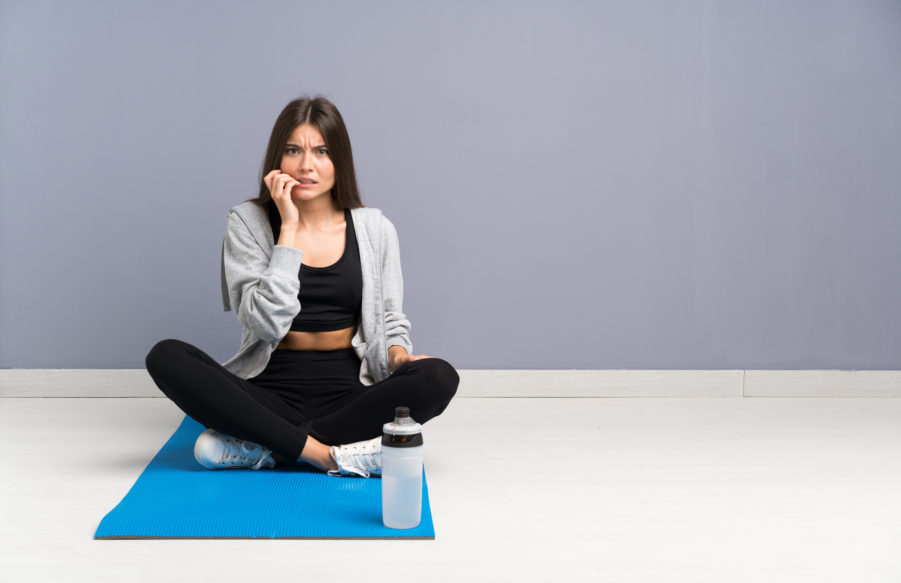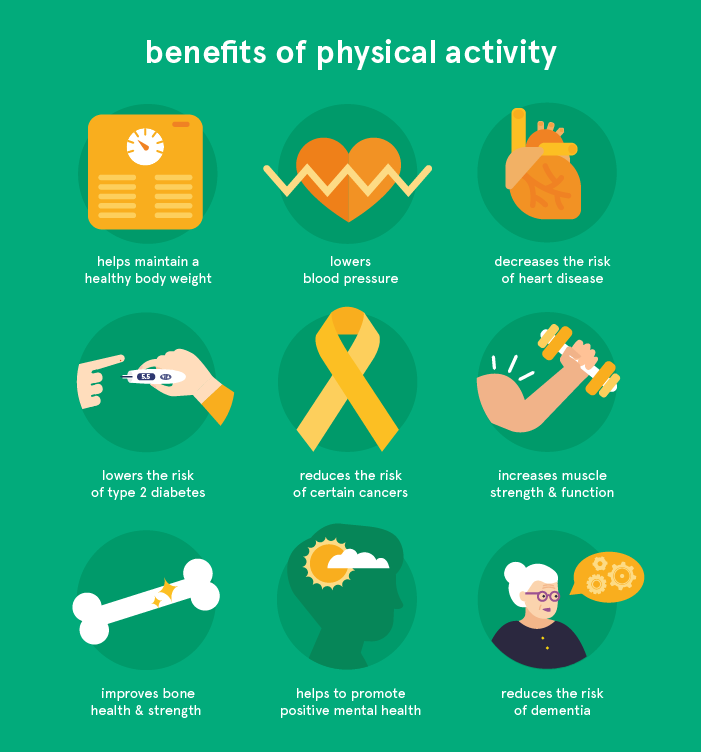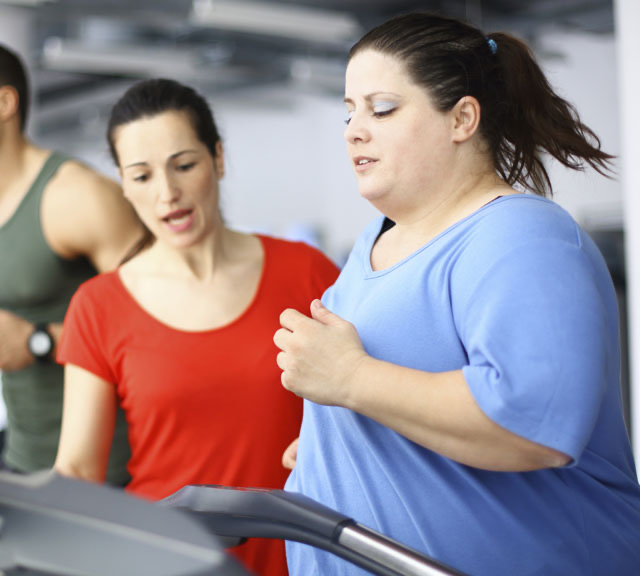
Overcoming “Gym Anxiety”
A recent study conducted by the Global Health & Fitness Association, showed that 50% of Americans are too intimidated to visit a gym and workout around other people. Signing up for a gym membership may be a breeze for some, but it is a gut-wrenching thought for many. Fear of being judged, fear of appearing confused, not knowing how to exercise with proper form, and fear of injury are just a few things that cause someone to experience “gym anxiety”. We need to be empathetic of gym anxiety because it harms people emotionally, physically, socially, and psychologically. I can’t help but assume that gym anxiety is a contributing factor for America’s worrisome health statistics. Gym anxiety is nothing new. However, between the pandemic, modern pop culture, social media, and the pressure we put on ourselves these days, it has drastically amplified in recent years.
Oxford languages defines anxiety as “a feeling of worry, nervousness, or unease, typically about an imminent event or something with an uncertain outcome.” Worrisome thoughts, unpredictable scenarios, and new environments can generate physical symptoms like accelerated heart rate, excessive sweating, shaking, dry mouth, shortness of breath, muscle tension and even panic attacks. Registered Dietician Meg O’rourke and I recently discussed how anxiety has become such a challenging barrier for people attempting to make lifestyle changes. We both have years of experience working with clients who meet this criterion, which is why we decided to team up and give our advice. Meg specializes in nutrition and has worked with many clients whose anxiety triggers things like emotional eating, overeating, and reluctance to dietary modifications. I on the other hand specialize in fitness and I know several people who realize they need to exercise but are apprehensive of getting into a gym.
The Statistics Speak for Themselves
American obesity rates are skyrocketing. We have been living through a global pandemic for the past two years and obesity is a huge co-morbidity associated with this deadly virus. It is crucial we start directing more attention to healthier eating habits and exercise. Why the media refuses to deliver this message with urgency is beyond me. In 2010 the American obesity rate was 35.7%, in 2020 it was 42.8%, and according to the CDC, in 2030 it will be 48.9%. If you combine the number of Americans who are currently overweight with the number of Americans who are obese, it then becomes 70%. Pandemic or not, this is a terrifying reality. Obesity increases one’s risk for respiratory disease, heart disease, high blood pressure, diabetes, cancer, joint problems, gout, liver disease, colon and digestive problems, skin problems, sleep problems, memory and cognitive problems and mental health issues. You know what significantly helps control obesity? Consistent exercise!
The benefits of physical activity go far beyond burning fat, getting shredded arms, or working for that six-pack next beach season. The real benefits occur beneath the surface, all the way down to the cellular level. Just because you may not see rapid results on the exterior, understand that every workout you complete is improving your overall health, the key is to keep it up consistently.

Still Not Psyched About Going to a Gym?
Consider These Five Tips!
1 – Mentally Prepare
Ever wonder why it’s so difficult for someone to give up smoking? When modifying a behavior, cutting a bad habit, or wanting to make a lifestyle change like going to a gym, the path to success is best described as moving through stages. The transtheoretical model (Prochaska & DiClemente, 1983; Prochaska, DiClemente, & Norcross, 1992) was constructed to describe the process of behavior change. This model lays out a series of five stages one follows to successfully make a change.
- Precontemplation stage – People in this stage are not yet intending to take action anytime soon and are unaware of the consequences of their behavior.
- Contemplation stage – This is the stage where people start thinking about making a change in the near future. They’re becoming aware of the benefits of changing, but are stuck in a procrastination period.
- Preparation Stage – This stage is where people intend to take action in the immediate future.
- Action Stage – Action stage is the stage in which people have made specific adjustments in their lifestyles.
- Maintenance Stage – This is the stage in which people have made specific changes in their lifestyles and are working to prevent backtracking.
2- Schedule a Tour with a Personal Trainer
Having a fitness professional by your side each step of the way will have a powerful impact on your new routine. Call and schedule a tour at a nearby gym so you can meet some of the trainers before-hand to discuss in detail what your specific goals are. A good trainer will hear you out and use the information you provide to him/her so he/she can develop a program specific for you. By doing this, you won’t have to worry about being unsure of what to do at the gym once you get there. All you will need to do is walk through the door and your trainer will have everything covered. They’ll be there to encourage you and introduce you to new exercises and show you how to perform them safely and effectively. It’s important to ensure the trainer you hire is a good match for you and that you’re comfortable around them. For example, you may naturally gravitate toward a female or male trainer. Your trainer will have more of an impact on your life than you realize, so you’ll want it to be somebody you can trust. Some key things to look for are education, experience, and credentials. I would suggest asking if the trainer has a college degree and/or any certifications to ensure you are in good hands.
3 – Buy Workout Clothes and Sneakers
Nothing solidifies that feeling of readiness quite like buying some brand-new workout clothes and a fresh pair of sneakers. Treat yourself to something nice and comfortable so that you feel confident when you walk through those gym doors. Give yourself a pat on the back after purchasing your new gear because this act in and of itself is an accomplishment.
4- The Buddy System Works!
Let’s be real, not everybody is self-motivated. Especially if exercise is new to them. A common scenario that we’ve all experienced at one point or another is the classic, “I’m going to go to the gym after work today.” Then next thing you know a handful of excuses to skip your workout fogs your mind. You then convince yourself you’ll make it up tomorrow but skip it again. Then you the miss the whole week, which turns into a month, and so on and so forth. Workout buddies help hold each other accountable. When you commit to each other that you’re going to meet up at the gym after work, the likelihood of that actually happening is much greater than if you were to go at it alone. You don’t want to let your friend down, do you?
5 – Seek Nutritional Help
Dietary modifications and exercise are the perfect 1-2 punch to a healthier you. Regardless of what you’re training for (weight loss or strength gains) you can’t have one without the other. You can’t outwork a bad diet, and you will not get the best results possible without pairing healthy eating with exercise. This is where I will hand it off to Meg for her two cents!
Stop drinking diet soda or drinks such as Crystal light
Did you know that “fake” sugar is 300-800 times sweeter than real sugar? This can cause an insulin surge. (technical term is hyperinsulinemia). Insulin is a hormone that can cause weight gain when we consume diet drinks, and other sources of “fake” sugar.
Stop telling yourself that everyone is “looking at you” when walking outside or at the gym.
People are busy and do not have time to worry about what you are doing. Say things to yourself that are positive and encouraging. For example,” I am going to kill this workout today”.
Does Fruit have too much sugar in it?
That would be like saying “Is water too wet?” Fruit is made of monosaccharides, which is a simple sugar. Fruit has fiber, antioxidants and other cancer fighting ingredients. Nobody is getting overweight from eating fruit.
Emotional Eating
Are you using food as a coping mechanism? Food is not a hobby. Food is meant to give us energy and make us feel satisfied. When we overeat, we self-sabotage. This makes us feel tired, increases anxiety, and can cause feelings of guilt. Find other hobbies that have nothing to do with food to keep you busy.
Food and Mood
Too much sugar from refined carbohydrates (cakes, cookies, chips etc.) can cause us to feel “wired and tired.” The foods we eat can totally affect our mood. This can also affect our sleep patterns. This can lead to producing less cortisol. Cortisol is the hormone that helps break down fat and synthesize lean muscle mass. (Remember the more muscle you have, the faster your metabolism is – A dirty little secret the big weight loss companies try to hide). In other words, less cortisol due to lack of sleep means a slower metabolism and less fat breakdown. Experts say we need anywhere from 7-8 hours of sleep.
Michael has been a strength coach at Olympia Fitness and Performance for three years. Michael graduated from Rhode Island College where he studied Community Health & Wellness with a concentration in Wellness & Movement studies. After graduating, Mike went on to get his CSCS (certified strength and conditioning specialist) through the NSCA. He is also a Certified Speed and Agility Coach, as well as a TPI certified coach. In his three years as a strength coach, Mike has helped clients from all walks of life improve their fitness levels. He has a strong passion for helping young athletes not just improve their athletic performance, but also helping them build confidence.


